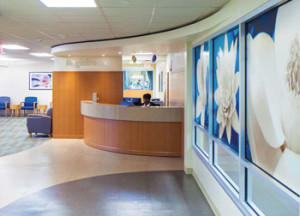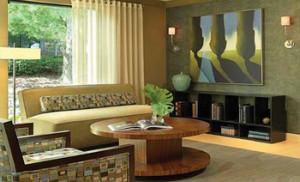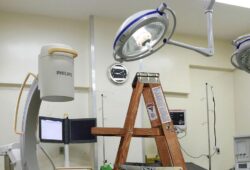It’s easy to feel depressed or stressed when staying in or even visiting the hospital. The blank walls, fluorescent lights and monochromatic color schemes can be bleak and dreary. According to the Center for Health Design, humanizing the hospital’s environment with carefully chosen artwork improves several health outcomes, including length of stay, the need for pain medications and patients’ satisfaction with healthcare services. Artwork that takes such outcomes in mind is called evidence-based design (EBD).
 Design companies such as ARCH Framing and Design Inc. are responding to the patient satisfaction challenge by offering custom artwork and designs for hospitals and healthcare facilities nationwide that fit in with EBD parameters.
Design companies such as ARCH Framing and Design Inc. are responding to the patient satisfaction challenge by offering custom artwork and designs for hospitals and healthcare facilities nationwide that fit in with EBD parameters.
The designers at ARCH Framing and Design are certified in EBD, says Paul Burton, president. “We support and lead our clients’ artwork selection based on the most current findings from research done in the field of EBD.”
Burton’s team of consultants and designers works with hospitals on an individual basis, helping facilities choose artwork from local or regional artists.
Priscilla Burton, the lead healthcare designer, explains that each project is completely customized.
“Every location, hospital and community is different,” she says. “We don’t keep artwork stored in the warehouse. Everything is specifically designed for that community and facility to reflect a personality.”
Artwork is also beneficial for dementia and Alzheimer’s patients, according to a study in the Journal of Alzheimer’s Disease (Vol. 39, 2014). Healthcare designers work with senior living facilities and hospitals to fill care rooms with images of community attractions, hobbies and activities familiar to patients.
 “We don’t put images of snow-capped mountains in our centers in Florida,” Priscilla explains. “This is huge in senior living facilities. You want to honor how long people have been living and participating in their community. We’ve learned that a piece of artwork can jog someone’s memory.
“We don’t put images of snow-capped mountains in our centers in Florida,” Priscilla explains. “This is huge in senior living facilities. You want to honor how long people have been living and participating in their community. We’ve learned that a piece of artwork can jog someone’s memory.
“However, we don’t just throw pictures on the wall because they’re empty,” she continues. “If a hospital is going to spend money on art, then it needs to be amazing. It needs to have a purpose.”
For more information, visit www.archframing.com.
Share Email





